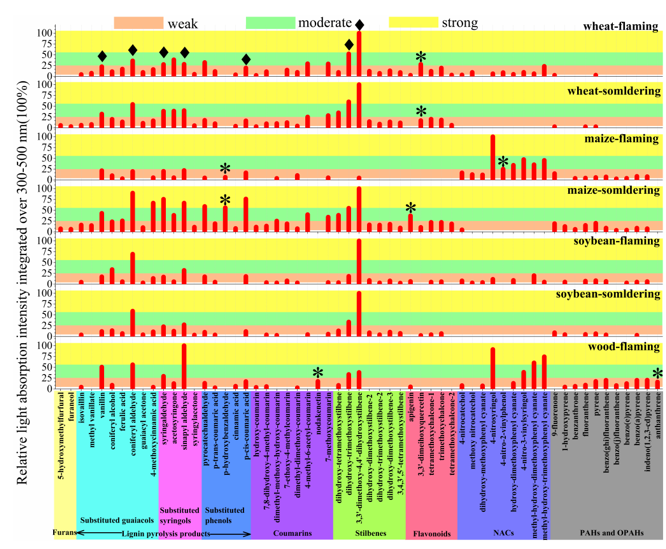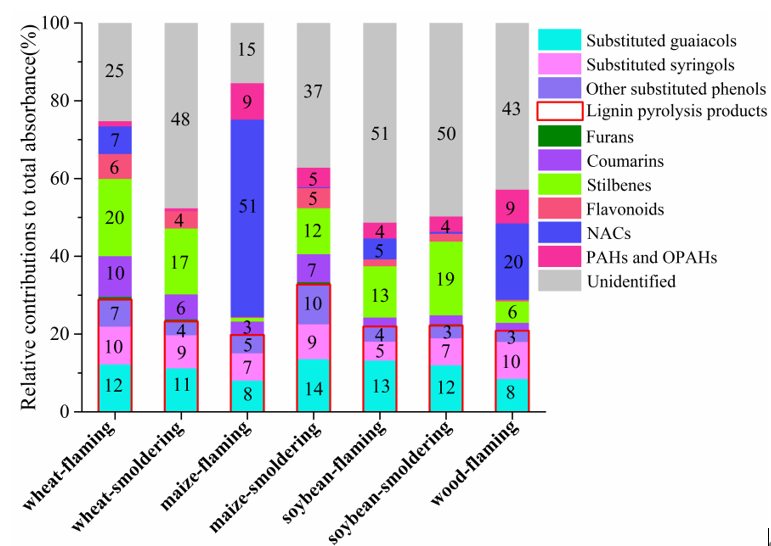Ru-Jin Huang*, Lu Yang, Jincan Shen, Wei Yuan, Yuquan Gong, Haiyan Ni, Jing Duan, Jin Yan, Huabin Huang, Qihua You, and Yong Jie Li, Chromophoric Fingerprinting of Brown Carbon from Residential Biomass Burning, Environ. Sci. Technol. Lett. 2022, 9, 2, 102–111.
Emissions from residential biomass burning are a significant source of atmospheric brown carbon (BrC).
A research group led by Prof. HUANG Rujin from the Institute of Earth Environment (IEE) of the Chinese Academy of Sciences applied liquid chromatography-photodiode array-high resolution tandem mass spectrometry to investigate the chromophoric fingerprinting of BrC emitted from residential biomass burning. In total, 59 major chromophores were identified, which accounted for 49-85% of the total light absorption of BrC (averaged between 300 and 500 nm) for different samples. These chromophores include furans, lignin pyrolysis products, coumarins, flavonoids, stilbenes, N-containing aromatic compounds, and unsubstituted or oxygenated polycyclic aromatic hydrocarbons, of which some are newly reported as BrC species (e.g., stilbenes and substituted phenyl cyanates). Among the chromophores identified, seven are common to all samples while some are specific to certain biofuel or burning conditions. For instance, 3,3′-dimethoxyquercetin from wheat burning, p-hydroxybenzaldehyde and apigenin from maize smoldering, 4-nitro-2-vinylphenol from maize flaming, and nodakenetin and anthanthrene from wood flaming are specific to the fuel type or burning condition.
This study, published in Environ. Sci. Technol. Lett. will be essential for understanding atmospheric chemical and optical processes of biomass burning BrC in future studies, which is a key for estimating source-specific radiative forcing.
This work was supported by the National Key Research and Development Program of China (2017YFC0212701), the National Natural Science Foundation of China (NSFC) under Grants 41925015 and 41877408, the Chinese Academy of Sciences (ZDBS-LY-DQC001 and XDB40000000), the Cross Innovative Team fund from the State Key Laboratory of Loess and Quaternary Geology (SKLLQGTD1801), and the Science
and Technology Development Fund, Macau SAR (0019/ 2020/A1).

Fig 1. The BrC chromophore profiles for wheat, maize, soybean, and wood burning aerosols. The normalized abundance of all BrC chromophores are binned as weak (3-20%), moderate (20-50%), and strong (50-100%). The symbols above the drop lines donate the common (◆) and specific (*) BrC chromophores in different fuel types or burning conditions.

Fig 2. Relative contributions of each BrC chromophore group to the total absorption (averaged over 300-500 nm) of BrC extracts in different BBOA samples.

